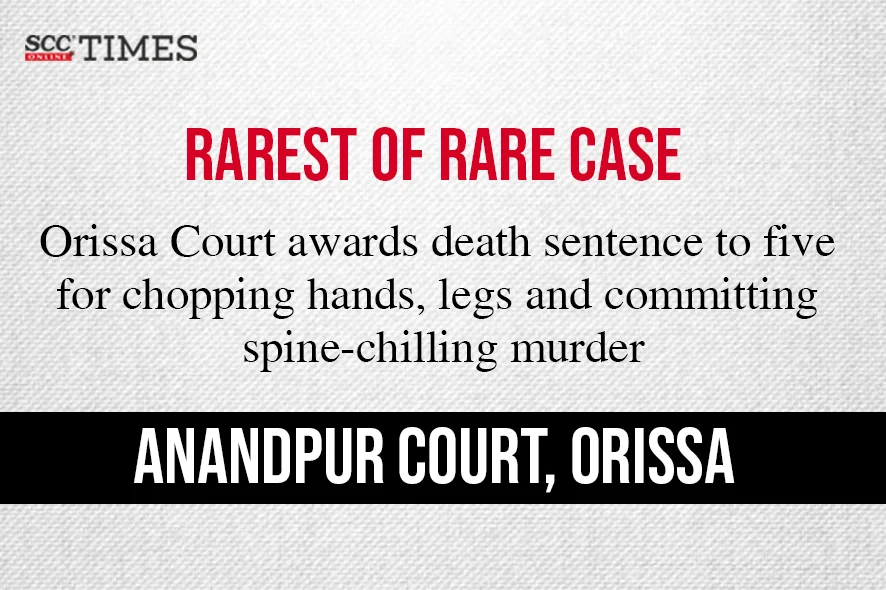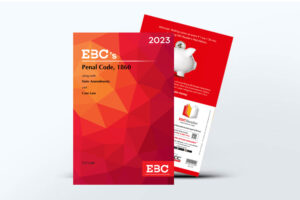Anandapur Court: Prajyoti Rout, Additional District and Sessions Judge, Anandapur, sentenced five accused persons to death for offences under Section 302 read with Section 34 and 120-B of the Penal Code, 1860. The Court termed the matter at hand as “rarest of rare case”.
Factual Matrix
On 25-03-2019 at about 10:30 P.M. the accused persons called the informant’s father (‘deceased’) outside his house and assaulted him. The accused persons cut off his hands and legs with a knife and sword and later he succumbed to his injuries. The Inspector rank officer upon receiving the written report from the deceased’s daughter (‘informant’) registered a case under Section 326 read with Section 307 and 34 of the Penal Code, 1860 (‘IPC’). The Investigating Officer recovered the cut hands of the deceased from the Brahmanidevi dam at the instance of the accused persons and also, seized the wearing apparels as well as biological samples of the deceased and accused persons, alleged weapon of offences, motorcycles, certain documents etc. A charge sheet was submitted under Sections 120-B read with Sections 302 and 201 of the IPC and Section 25(a) read with Section 27(1) of the Arms Act, 1959 vide charge sheet dated 22-07-2019.
Analysis
The Court perused the statements of all the prosecution witnesses and said that the injuries were such as to cause instantaneous death. The Court noted that on the way to the hospital, the deceased succumbed to his injuries and that his hands and palm were chopped into pieces and recovered from Brahmanidevi dam. The Court said that the informant and her sister (the daughters of the deceased) were the star witnesses of the matter at hand to witness the entire incident. The Court noted that the daughters of the deceased had deposed that the accused persons came to their house and called their father outside and assaulted the deceased mercilessly with deadly weapons i.e., bhujali, tamil kata and sword, they cut his hands and toes and thereafter, took away the cut hands. Further, the Court perused the wife’s statement, that she went outside and found her husband was lying on the ground sustaining bleeding injuries and his both hands and legs were cut and that she had seen all the accused persons being armed with different lethal weapons were fleeing from the spot.
The Court also noted that while the deceased was taken to the hospital by an Ambulance, his daughter asked the leading questions to the deceased i.e., whether the accused persons assaulted him and in affirmation symbolically, the deceased raised his head, and the said conversations were recorded by her on the mobile phone. The Court noted that the medical officer had stated that on the alleged date of occurrence at about 11 P.M., he examined the deceased and found multiple injuries like amputation of left-hand incised wound under right hand and the patient was in state of shock and unable to speak and he was absolutely in critical state.
Regarding the discovery of the cut hands, the Court noted that the I.O. along with the accused persons went to Brahmanidevi dam and that one of the accused had shown him the place where he threw the cut hands of the deceased. The Court also perused the two fire man’s statements, who had discovered the hands from the dam. The Court viewed that the evidence of the informant was well corroborated with the inquest reports, postmortem reports, query report, chemical examination report and the DNA report and hence, the evidence of the informant and the other daughter of the deceased was clear and cogent. The Court also relied upon Brahm Swaroop v. State of U.P., (2011) 6 SCC 288, wherein it was held that “the relationship of the victim to one of the parties is not a factor that effects the credibility of a witness, more so a relation would not conceal the actual culprit and make allegations against an innocent person.”
The Court said that the victim or the relatives of the victim are always interested to see that the real offender of the crime is booked and roped in the innocent persons. The Court said that it is not a safe rule to reject the entire testimony of the witness merely on the grounds that the informant as well as the other eye-witnesses were the relatives of the deceased and interested witnesses. The Court added that there was intention on the part of the accused persons to cause the death of the deceased for which they mercilessly assaulted him with the deadly weapons and cut the hands and legs of the deceased and the evidence in the digital document clearly showed that the accused persons intended to kill the deceased. Further, the Court said that the DNA profile was tallied with the blood stain available on the weapons of offence recovered from the accused persons and the digital documents extracted from the mobile phones of the accused persons clearly indicated the participation and involvement of the accused persons in the murder of the deceased.
Decision
Hence, the Court said that upon considering the entire gamut of evidence, the prosecution satisfactorily proved the barbaric, blood thirsty and spine-chilling act of the accused persons. The Court said that all the accused persons were acting in concert, existence of a pre-arranged plan proved from their conduct, the circumstances and the incriminating facts and all the accused persons are guilty of murder of the deceased. The Court held that the accused persons guilty for offences under Sections 302/34/120-B/201 of the IPC read with Section 25(a)/27(1) of the Arms Act.
On the quantum of sentence, the Court said that the law is fairly settled that the punishment awarded should be directly proportionate to the nature and gravity of the case and the magnitude of the offence. However, for imposing death penalty, a balance sheet of aggravating and mitigating circumstances was drawn by the Court, and it was said that the accused persons mercilessly assaulted the deceased and cut his hands and legs and roamed in the village by carrying the cut hands of the deceased to create havoc in the society. They chopped the said cut hands into many pieces for their sadistic pleasure and cruel delight and attempted to eat the same by putting it in the mouth of one of the accused, showing the character of demon. The Court stated that the series of inhuman acts of the accused persons involved extreme brutality and exceptional depravity and the crime was committed in an extremely brutal, grotesque, diabolical, revolting and dastardly manner. The Court viewed that the matter at hand was “rarest of rare case” and the accused persons did not deserve any mercy and awarded death sentence to them under Section 302 read with Section 34 and 120-B of the IPC and the capital punishment was to take effect subject to the confirmation of the Orissa High Court.
[State of Odisha v. Chilu, 2024 SCC OnLine Dis Crt (Ori) 1, Decided on 05-03-2024 and Sentence has been pronoun on 06-03-2024]








